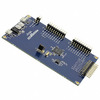Norton Theorem Basics and Circuit Examples
If you've ever looked at a complex circuit and wondered how to make sense of it, Norton’s Theorem can help. It gives you a way to simplify a whole section of a circuit into something much easier to work with. Instead of dealing with many components, you replace them with just a current source and a resistor in parallel. This makes it quicker to analyze how current and voltage behave, especially when the load changes. Whether you're learning circuit basics or looking for a better way to solve problems, this method keeps things clear and manageable. In this article, you'll learn what Norton’s Theorem is, how to apply it, and why it's useful for simplifying circuit analysis. Everything is explained step by step so you can follow along easily.Catalog

Figure 1. Norton’s Theorem in Circuit Analysis
Introduction to Norton’s Theorem in Circuit Analysis
Norton’s Theorem is a helpful tool when working with electrical circuits, especially if you're looking to simplify a complex circuit to make analysis easier. The idea behind it is that any linear electrical circuit with resistors and sources can be replaced with a simpler version that behaves the same way from the load's point of view. This simpler version is called the Norton equivalent circuit.
Instead of dealing with a messy network of components, Norton’s Theorem lets you focus on a circuit made up of just a single current source in parallel with one resistor. You can then connect your load to this simplified version and easily figure out things like how much current flows or what voltage appears across it.
This method works best with circuits that are linear—which means they follow Ohm’s law and don’t have complicated elements like diodes or transistors that behave non-linearly. It’s also a great way to compare with Thevenin’s Theorem, which does something similar but uses a voltage source in series with a resistor instead.
Understanding Norton’s Theorem gives you a new way to look at circuits, making the math and analysis more manageable. It’s especially useful when you're testing how different load resistors affect a circuit, since once you’ve found the Norton equivalent, you don’t have to go through the full analysis again every time the load changes.
How to Use Norton’s Theorem in a Circuit?
Before using Norton’s Theorem, it’s important to know that it only works with linear circuits. A linear circuit is one where the current and voltage follow a straight-line relationship—no exponents, no square roots, just basic components like resistors, capacitors, and inductors. This means that any current or voltage you calculate will behave predictably, which is exactly what we want when trying to simplify and understand circuits.
Norton’s Theorem comes in handy when you’re trying to figure out how a load—like a resistor—behaves within a larger, more complex network. Rather than solving the whole circuit every time the load changes, you can turn the rest of the circuit into something much simpler: a current source in parallel with a resistor. This is what’s called the Norton equivalent.

Figure 2. Circuit Schematic for Explaining Norton’s Theorem
To make things clearer, we’ll walk through this theorem using a sample circuit that’s also been used in other analysis methods like Branch Current, Mesh Current, Superposition, Thevenin’s, and even Millman’s Theorem. Sticking with the same example lets you compare how different techniques work on the same problem. It gives you a better understanding of which method might be easier or more useful depending on the situation.
Here’s a quick look at those methods:
Branch Current Method – Current in Each Path
This method assigns a current to every branch in the circuit. You use Ohm’s Law and Kirchhoff’s Current Law to form equations. It's simple but can involve more math if the circuit has many branches.
Mesh Current Method – Current in Loops
Here, you assign a current to each loop instead of each branch. Using Kirchhoff’s Voltage Law, you form fewer equations than the branch method. It works best for circuits without crossing wires.
Superposition Theorem – One Source at a Time
This method breaks the circuit down by looking at one power source at a time, turning off the others. You solve for each source’s effect, then add all results together to get the full picture.
Thevenin’s Theorem – Voltage Source Version
You simplify part of a circuit into one voltage source and one resistor in series. It’s great when testing different loads because the simplified circuit stays the same.
Millman’s Theorem – Simplifying Parallel Sources
Used for circuits with multiple parallel voltage sources, Millman’s formula combines them into one simple equivalent. It’s quick and neat for solving these setups.
By the end of this process, you’ll see how powerful and convenient Norton’s Theorem can be, especially when analyzing multiple load conditions. It helps reduce a lot of repetitive work and gives you a simpler way to look at how current flows in the circuit.
Understanding the Norton Equivalent Circuit
Norton’s Theorem lets you take a complicated circuit and break it down into something much easier to handle. The key idea is that you can remove the load resistor from the original circuit and replace everything else with a single current source in parallel with a resistor. This simplified version is called the Norton equivalent circuit, and it behaves exactly like the original circuit when the load is reconnected.
By doing this, you're not changing how the circuit works—you’re just making it easier to understand and calculate values like current through the load or voltage across it. The load resistor can be reattached to this Norton equivalent, and since it’s now part of a basic parallel setup, finding the necessary values becomes much simpler. You don’t have to deal with all the original components every time. This is especially helpful if you’re trying different load values, because once you’ve built the Norton equivalent, you can reuse it again and again.

Figure 3. Norton Equivalent Circuit with the Load Resistor
When you look at the Norton equivalent, remember that the current source plays a specific role—it pushes a fixed amount of current through the circuit, adjusting its voltage as needed to maintain that current. This is different from a voltage source, which tries to hold a steady voltage no matter what. That’s why this model works well for circuits where current flow is more important to analyze than voltage.
So, using the Norton equivalent gives you a clear and flexible way to study how the circuit behaves, especially at the load. It reduces the complexity while still giving accurate results, and that makes it a great tool in circuit analysis.
Steps to Find Norton Equivalent Circuit (Current and Resistance)
Norton’s Theorem gives you a simple way to take a more complex circuit and turn it into a form that’s easier to work with. This is especially helpful when you want to understand how different load resistors affect a circuit without going through a full set of calculations each time. The process of finding the Norton equivalent involves a few clear steps. These include identifying and removing the load resistor, finding the Norton current, calculating the Norton resistance, and finally drawing the simplified Norton circuit. Let’s go through each of these steps carefully, using a practical approach and keeping things simple.
Step 1: Take Out the Load Resistor
The first thing you’ll do is locate the load resistor—this is the part of the circuit you’re mainly interested in. It’s where you want to know the current or voltage. Once you’ve identified it, remove the load resistor completely from the circuit. This leaves the rest of the circuit intact, and now your focus shifts to everything else that remains.

Figure 4. Remove the Load Resistor
With the load removed, you’re left with two open terminals where the resistor used to be. These are the points between which you’ll build your simplified Norton equivalent. It’s important to do this step first because all the other calculations depend on what the circuit looks like without the load connected.
Step 2: Find the Norton Current
Now that the load resistor has been removed, the next step is to find the Norton current (INorton). This current represents how much flow would occur if you connected a perfect wire (a short circuit) between the two open terminals where the load resistor used to be. By doing this, you're creating a path of zero resistance, and this allows you to calculate the full current that the circuit would push through that path.

Figure 5. Calculate the Norton Current
This step is different from what you do in Thevenin’s Theorem, where instead of shorting the terminals, you leave them open and calculate the voltage across them. Here, we’re doing the opposite—you create a direct connection and measure the current through it.
Let’s break down the calculation.
The circuit in this example contains two branches:
One branch has a 28 V source and a 4 Ω resistor (R1)
The other branch has a 7 V source and a 1 Ω resistor (R2)
The point between R1 and R3 is shorted directly to the negative ends of both voltage sources. According to Kirchhoff’s Current Law (KCL), the total current through the short is the sum of the individual branch currents:

Now apply Ohm’s Law to each branch current:

So, the total short-circuit current becomes:

This 14 A is what your Norton current source will supply in the final simplified circuit. It's the key value that shows how strongly the original circuit pushes current when the load path is completely open for flow.
Step 3: Turn Off the Power Sources
To find the Norton resistance, you now need to look at how the circuit behaves when all power sources are turned off. This means replacing voltage sources with a short circuit (just a wire) and current sources with an open circuit (a break in the line).

Figure 6. Replace the Power Sources in the Circuit
Doing this allows you to see only the resistance that exists in the network between the two open terminals. It’s a very common technique used not only in Norton’s Theorem but also in Thevenin’s and superposition methods. You’re removing the energy sources so you can focus purely on the resistive part of the circuit.
Step 4: Work Out the Norton Resistance
After you’ve turned off all the power sources in the circuit—voltage sources replaced with short circuits and current sources replaced with open circuits—you’re ready to find the Norton resistance. This is done by calculating the total resistance seen between the two points where the load resistor was originally connected.

Figure 7. Calculate the Norton Resistance
In the given example, once the voltage sources are shorted, the resistors R1 (4 Ω) and R3 (1 Ω) are now directly in parallel between the open terminals. To find the equivalent resistance of two resistors in parallel, use this formula:

So, the Norton equivalent resistance is 0.8 ohms, and this value becomes the resistor in parallel with your Norton current source in the simplified circuit. It represents how the original network of components resists current flow from the perspective of the load.
Step 5: Draw the Norton Equivalent Circuit
Now that you have both the Norton current and the Norton resistance, it’s time to put everything together. Draw a circuit with a current source (with the value of INorton) in parallel with a resistor (with the value of RNorton). Then, reconnect your original load resistor to the same two terminals.

Figure 8. Draw the Norton Equivalent Circuit
This new circuit is your Norton equivalent circuit, and it behaves exactly like the original circuit as far as the load is concerned. The big advantage is that now you can use simple parallel circuit rules to calculate current and voltage through the load. If you want to test different load values, you don’t need to go through all the steps again. Just replace the load resistor with a new value and do a quick parallel analysis.
This process makes it much easier to study how a circuit responds under different conditions without repeating complex calculations.
Using the Norton Circuit to Analyze Load
Once you’ve finished all the steps to build the Norton equivalent circuit, the final part is using it to analyze the behavior of the load resistor. This is where everything comes together, and you see how helpful this simplified model really is. Now that the Norton current source and Norton resistance are in place, and the original load resistor has been reconnected, the entire setup becomes a simple parallel circuit.
In this form, finding the current through the load and the voltage across it is quick and clear. All you need is the total resistance seen by the current source, which is the parallel combination of Norton and the load resistor. You can calculate it using the formula:

With this value of total resistance, you can now use Ohm’s Law again to find the total voltage and the current through each resistor. Since it’s a parallel circuit, the voltage across both resistors (RNorton and the load) is the same. From the Norton current (14 A), you can break it down and figure out how much goes through each branch.
For this particular case, it turns out that the load resistor gets 4 A of current, and the voltage drop across it is 8 V. These are the two key values you usually care about—how much current is flowing through your load and what voltage it sees.
| |
RNorton | RLoad | Total | Units |
| V | 8 | 8 | 8 | V |
| I | 10 | 4 | 14 | A |
| R | 0.8 | 2 | 0.57143 | Ω |
Just like with Thevenin’s Theorem, you don’t need to worry about the rest of the circuit anymore. The only values that matter are those related to the load. This makes analysis easier, especially if you’re experimenting with different load values. You don’t have to redo every calculation—just plug the new load into the same Norton equivalent and solve a basic parallel circuit again. It saves time and keeps things much simpler.
Conclusion
Norton’s Theorem gives you a simple and effective way to work with linear electrical circuits. Instead of dealing with a large, complicated circuit every time you change a load, you can replace it with something much easier to manage—a current source in parallel with a resistor. This new version behaves the same as the original, but it's easier to understand and work with.
Throughout this article, you learned the five main steps to apply Norton’s Theorem:
• Remove the load resistor and replace it with a short circuit.
• Calculate the Norton current, which flows through the short.
• Turn off all power sources—voltage sources become wires, and current sources become breaks.
• Find the Norton resistance by looking at the total resistance between the open points.
• Draw the final Norton circuit, reconnecting the load and analyzing it using simple parallel circuit rules.
By using this approach, you can quickly figure out how a load will behave without having to start over every time. Whether you're testing different values or just trying to understand how the circuit works, Norton’s Theorem makes the process smoother and more efficient. It’s a handy tool for making sense of circuits and saving time while still getting accurate results.
About us
ALLELCO LIMITED
Read more
Quick inquiry
Please send an inquiry, we will respond immediately.
Frequently Asked Questions [FAQ]
1. What is Norton’s Theorem used for?
Norton’s Theorem is used to simplify complex circuits into a basic form with a current source and a resistor in parallel. This helps make it easier to analyze how different load resistors affect the circuit.
2. How is Norton’s Theorem different from Thevenin’s Theorem?
Thevenin’s Theorem uses a voltage source in series with a resistor, while Norton’s Theorem uses a current source in parallel with a resistor. Both give the same results, just in different forms.
3. Can I use Norton’s Theorem with any circuit?
You can use Norton’s Theorem with circuits made of resistors, voltage sources, and current sources, as long as the circuit behaves in a straight-line or predictable way (linear).
4. Why do we short the terminals to find the Norton current?
Shorting the terminals lets you measure the full current that would flow through the load position if it were a wire. This gives you the Norton current for your simplified circuit.
5. What happens after I build the Norton equivalent circuit?
After creating the Norton circuit, you reconnect the load resistor and analyze it using basic parallel circuit rules. This makes it easier to calculate current and voltage across the load.

EPM7256SQC208-10 Guide: Features, Pinout, Programming, Applications and Datasheet
on April 25th

Learn How XC2C512-10FT256C Can Help Your Design
on April 24th
Popular Posts
-

Understanding Power Supply Voltages in Electronics VCC, VDD, VEE, VSS, and GND
on June 13th 24175
-

USB-C Pinout and Features
on June 13th 21286
-

The Ultimate Guide to Wire Color Codes in Modern Electrical Systems
on January 1th 17465
-

TL494 Current-Mode PWM Controller IC
on January 1th 14733
-

Current Divider Circuits and Effective Use of the Divider Formula
on January 1th 13630
-

FET (Field Effect Transistor) Circuit Symbols
Field-Effect Transistors (FETs) are widely used in modern electronics and are found in everything from simple devices to complex digital systems. To work with these transistors effectively, it's helpful to understand the symbols that represent different types of FETs. These symbols do more than just show what the transistors look like—they also provide information about how each transistor works ...on January 1th 13440
-

Quality (Q) Factor: Equations and Applications
The quality factor, or 'Q', is important when checking how well inductors and resonators work in electronic systems that use radio frequencies (RF). 'Q' measures how well a circuit minimizes energy loss and impacts the range of frequencies the system can handle around its main frequency. In systems with inductors, capacitors, and tuned circuits, a higher 'Q' means the circuit focuses more on a spe...on January 1th 13393
-

Understanding and Building Op-Amp Based Peak Detectors
In the world of electronic circuit design, peak detectors are key tools for accurately analyzing and processing signal strengths. These circuits are designed to find and keep the highest signal amplitude, making sure the peak value is precisely captured and held as needed. Peak detectors are important in many fields, from improving audio quality in communication systems to aiding medical diagnoses...on June 13th 12497
-

LM741 Op-Amp: Features, Specifications, and Applications
The LM741 op-amp is a popular and flexible electronic component. This article goes over the pin layout, functions, specs, and different ways the LM741 can be used, while also comparing it to similar models like the LM358.Catalog1. What Is the LM741 Op-Amp?2. The LM741 Pin Configuration3. The LM741 Pin Functions4. Specifications of the LM7415. Features of LM7416. LM741 Circuit Applications7. LM741 ...on June 13th 12034
-

ST-LINK/V2: Pinout, Specifications, and Datasheet
This article takes you through the ST-LINK/V2, a well-regarded tool that amplifies connectivity and functionality. Key topics will cover its pinout configuration, delve into its 3D model, and spotlight specifications. Such understanding expands the horizons of STM microcontrollers in diverse applications. By grasping these interfaces and tools, you can transform embedded systems, opening doors to ...on January 1th 11579

















































